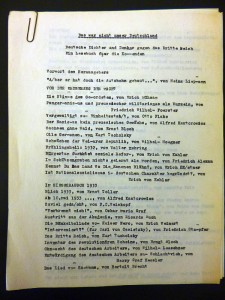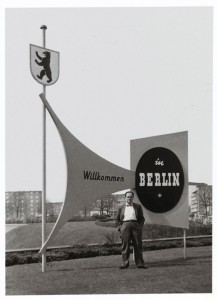Fred Stein was only twenty-four years old when he had to flee Germany in 1933. A rabbi’s son and member of the Socialist Workers’ Party, he had studied law and hoped to work as an attorney, defending people’s rights. When he learned by chance that the Gestapo was planning to arrest him, he and his wife Lilo fled to Paris under the pretext of taking a honeymoon trip. In exile, the young couple was obliged to rethink its future.
A Leica camera, the wedding present they had bought for themselves, proved to be the key to a new career. Fred Stein began taking photographs: street scenes in downtown Paris and portraits of celebrities, many of whom were German emigrants. In 1941 Fred and Lilo Stein, who by then had a little daughter, managed to flee a second time. They reached New York on one of the last ships out. There, Fred Stein once again devoted himself to shooting portraits and street scenes.
In 1958 Fred Stein returned to Germany for the first time in twenty-five years. He was prompted to do so by Will Grohmann’s planned publication of the book Deutsche Porträts [German Portraits]. Fred Stein was commissioned to photograph Konrad Adenauer, Heinrich Lübke, Ludwig Erhard, and other politicians, as well as artists, authors, and publishers, such as the young Axel Springer, or Rudolf Augstein. Yet apparently, many a German head he portrayed for the book posed a dilemma for him.
Subsequent to that trip, in the period 1962–67, the photographer focused on producing an anthology of excerpts from published texts by renowned authors who were critical of the Nazi regime, fascism, and racism. Many of the authors – Walter Mehring, Alfred Kantorowicz, Bertolt Brecht, and Hannah Arendt, for example – were his personal acquaintances or friends. All in all Fred Stein compiled over 200 texts, which he planned to complement by portraits of the authors. The title of the book – “That Was Not Our Germany: An Anthology for Future Generations” – had already been chosen and the preface already been written. Nevertheless, it proved impossible to complete the project. The Munich publishing house Kurt Desch refused to publish the work, claiming there was nothing original about an anthology of excerpts that were already in print and also that the proposed selection lacked rigor.

Index of Contents from Fred Stein’s unpublished project, “Das war nicht unser Deutschland: Eine Anthologie für die Kommenden”
© Estate of Fred Stein
The publishing house appears to have been right, for Fred Stein received two more rejections. The ambitious photographer must have been hugely disappointed. Stein died shortly thereafter, so the project remained in limbo.
Instead of an anthology, Fred Stein bequeathed to us portraits and other spontaneous photographs that bear witness to his life in exile. They are now on public display in our exhibition “In an Instant.”
Jihan Radjai, co-curator of the exhibition
